Today Raspberry Pi Trading announced the Raspberry Pi 400, the latest in the series of small education-focused computers that started with the original Raspberry Pi in 2012.
For years, people have come up with creative ways to hack a Pi into keyboards, like the Original Pi in an old Mitsumi keyboard, or the Pi 3 A+ in an official Pi Keyboard.
But the Pi 400 delivers something many have desired: an official Pi 4 board built right into a Pi Keyboard, in a space- and performance-efficient way.

This blog post will run through a full teardown and review of the Pi 400 and the rest of the official Kit you can purchase from the Raspberry Pi website for $100. (You can also buy the Pi 400 on its own for $70).
Videos: There are to videos that go along with this post:
What you get
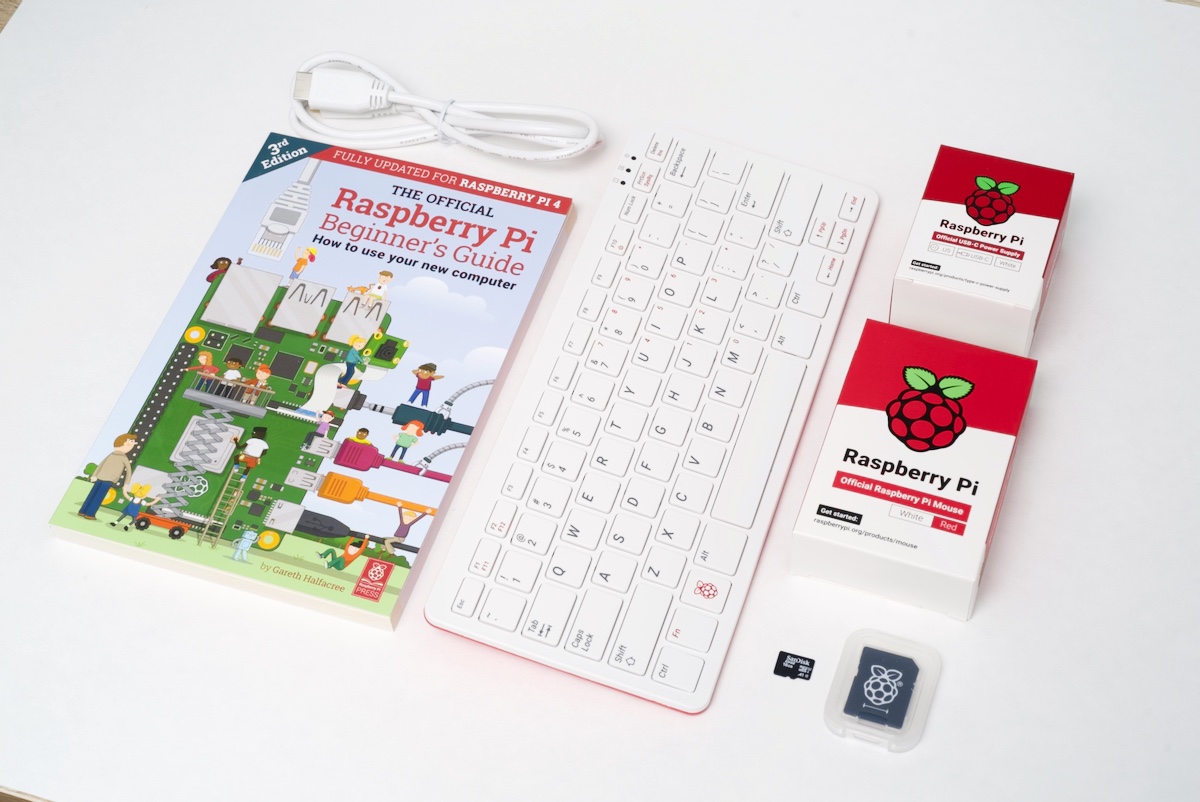
For $100, the Raspberry Pi 400 Kit gives you:
- The Pi 400 computer (1.8 GHz 4-core CPU, 4 GB RAM)
- The official Pi Keyboard (built-in; normally $20)
- A 16GB SanDisk Edge microSD card (normally $10)
- The official Pi USB-C Power Supply (normally $8)
- The official Pi Mouse (normally $8)
- The official Pi micro-HDMI to HDMI cable (normally $6)
- The Official Raspberry Pi Beginner's Guide (normally $10)
The equivalent cost Pi 4 model B (with a slower standard CPU clock) is $55, so the total for this entire bundle, purchased separately (and without the benefits the Pi 400 brings to the table) would be $117.
The kit's a great deal, but if you already have some or all of the required accessories, you can get the Pi 400 standalone for $70.
Comparison to the Pi Keyboard
Looking at the Pi 400 and Pi Keyboard from above, it's not obvious what's different—on top, the only change is the F10 Scroll Lock key now is used as a power button, and the Scroll Lock indicator is now a power/activity indicator.
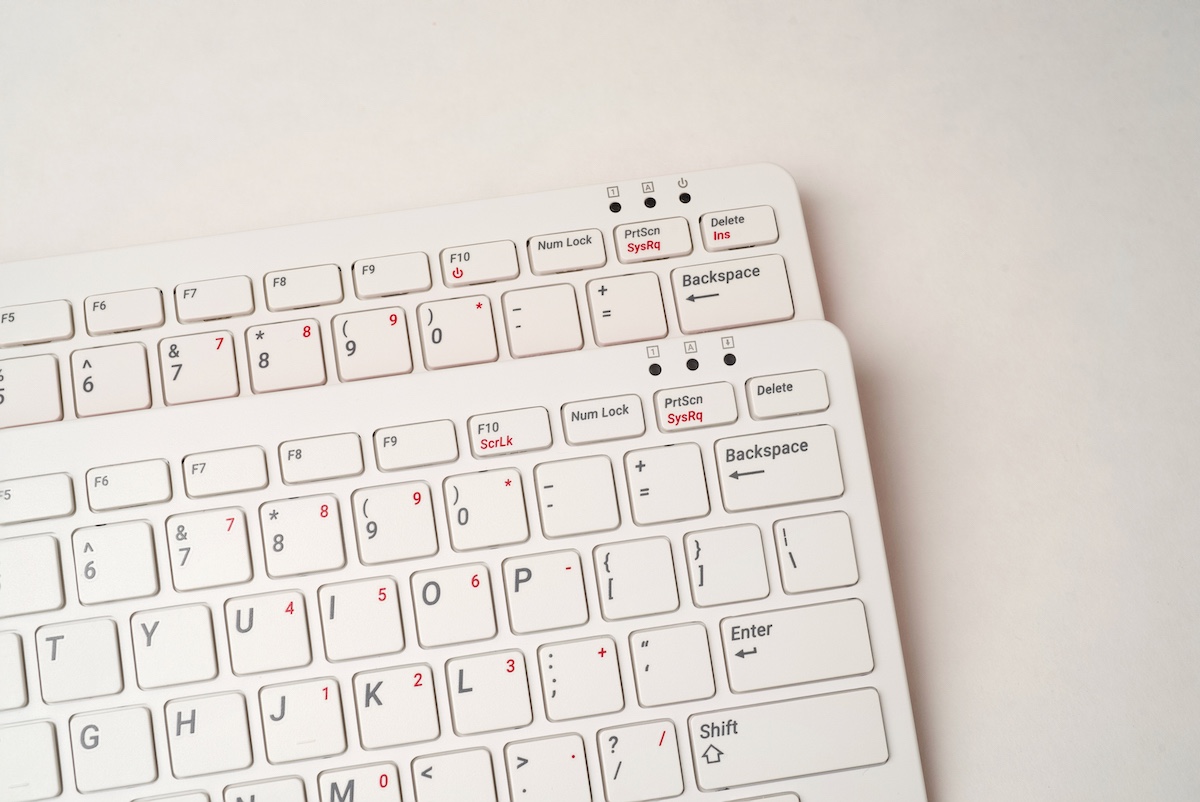
Aside: Has anyone reading this ever used scroll lock? I've at least used num lock before, but never scroll lock.
It's only when looking at the back that you see the major difference between the keyboard and the Pi 400—the latter has a full assortment of ports for use in general computing, even including the full 40-pin GPIO connection that's present on all Raspberry Pis since the Pi 2 model B!
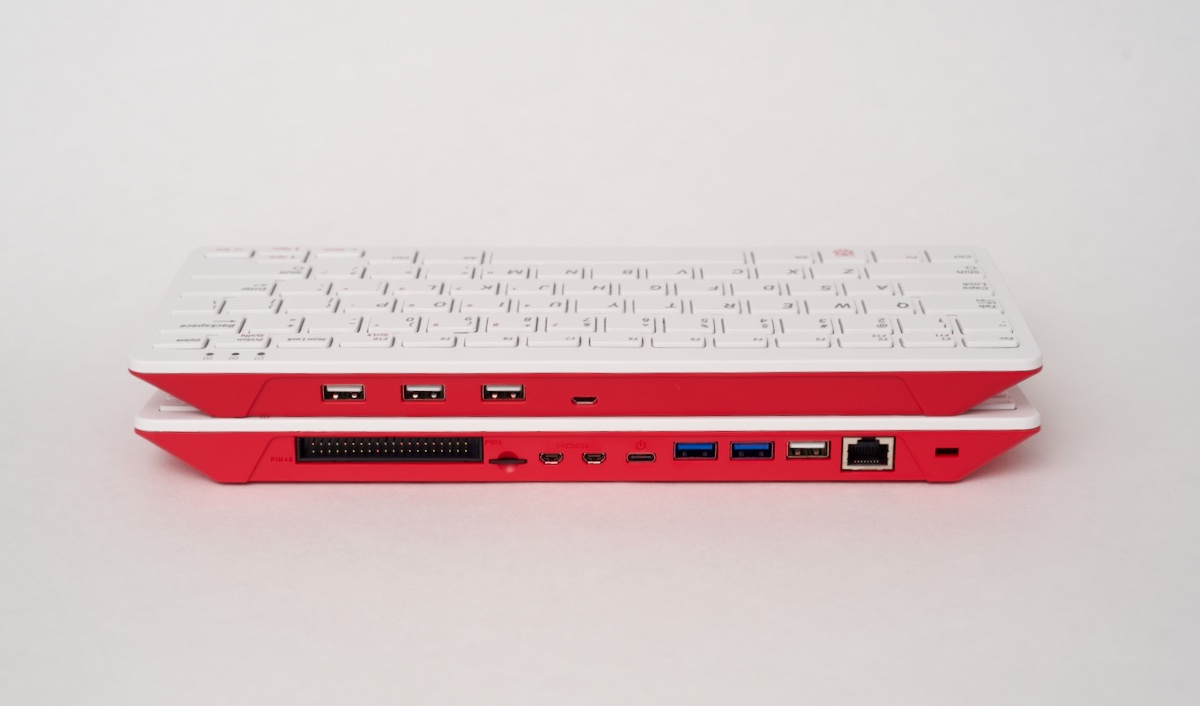
Pi 400 Teardown
Before we talk about how the Pi 400 works, though, let's take it apart!
Looking at the bottom, there aren't any screws or other fasteners, and the only difference from the regular keyboard is the inclusion of some vents and larger rubber feet.
To get it open, I used a plexiglass cutter, which is the only tool I have that's thin enough to get into the side clips that hold the white keyboard top to the red plastic shell underneath, but also rigid enough to un-pop the snaps. After working my way around the board, I could separate the keyboard top from the bottom half:

The keyboard just had a flip-up ribbon connector that I disconnected, and the next thing I noticed (besides that massive heat sink) is a little conductive pad in the top left corner, bridging the Ethernet jack, the heat sink, and the keyboard:
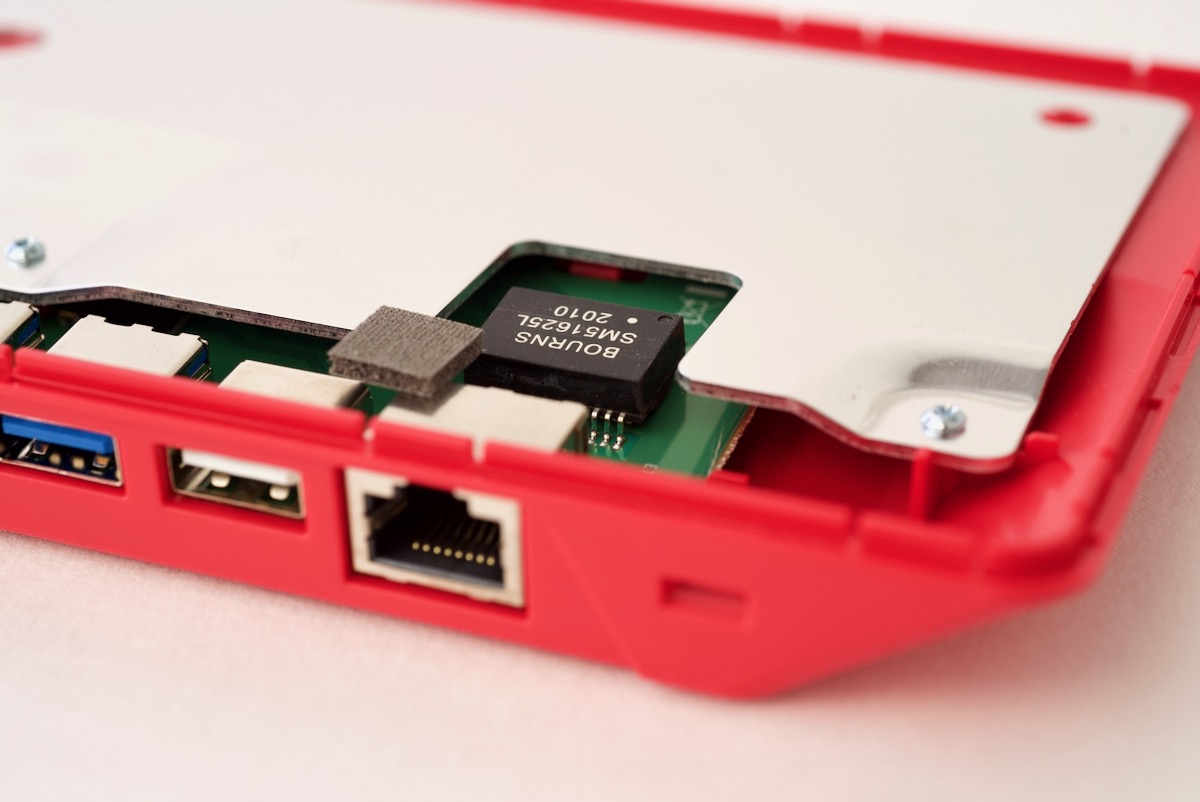
According to the Pi Engineer I asked, this pad is required to bond the ground from the back of the keyboard to the rest of the Pi 400's electronics.
The next thing I did was remove the four screws holding down the heat sink. Then I had to rock it back and forth a bit while pulling up to reveal that it is held down to the Broadcom SoC with a pretty sticky thermal adhesive pad:

Now, with the heat sink out of the way, you can see the Pi 400 is a completely different design than the Pi 4 model B and Compute Module 4, even though much of the circuitry is similar if not identical:

And flipping over the Pi 400 main board, we can see there's not too much on the back, other than a ton of traces connecting things through vias to the topside:
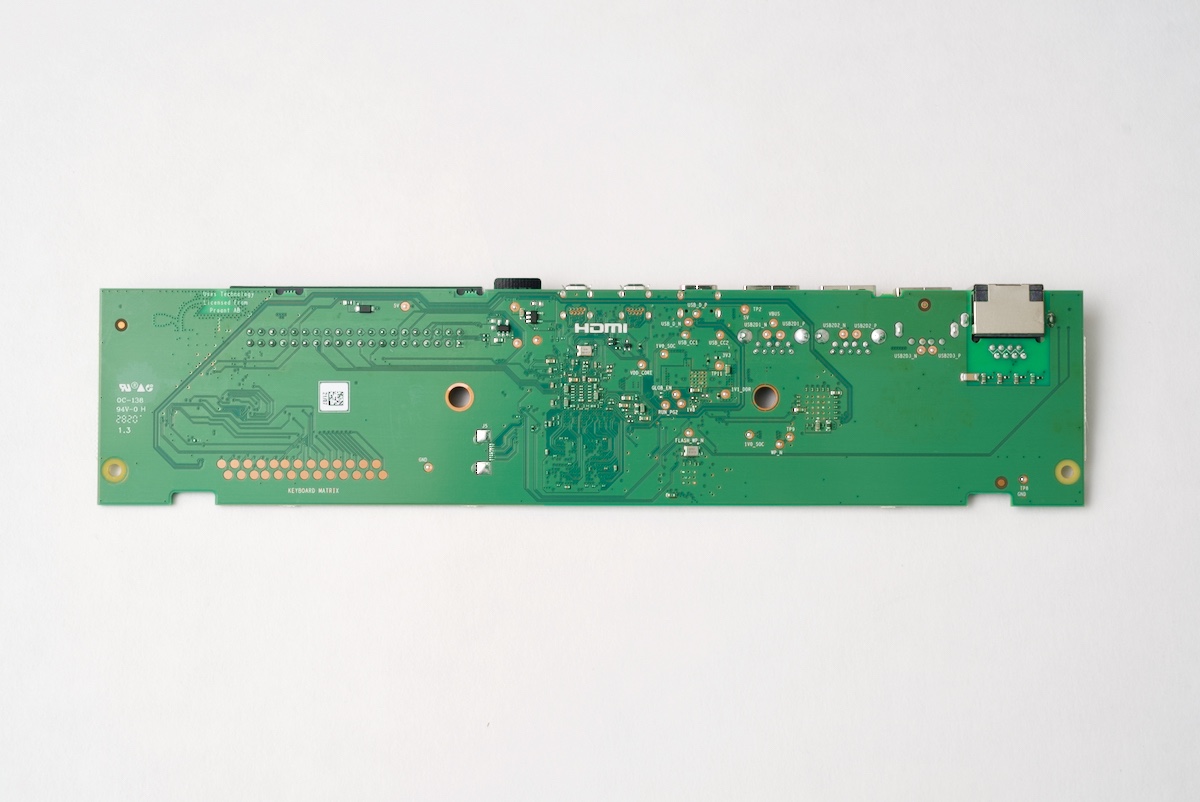
Looking more closely at the rear, though, you can see it uses the same PCB antenna for WiFi as found on other WiFi-enabled Pis, and from my experience testing the CM4, it's a pretty decent little antenna for having no external components!

And another quick shot of some of the labeling and traces in the part of the Pi 400 behind the main chips: SoC, network, and USB 3.0 controller:
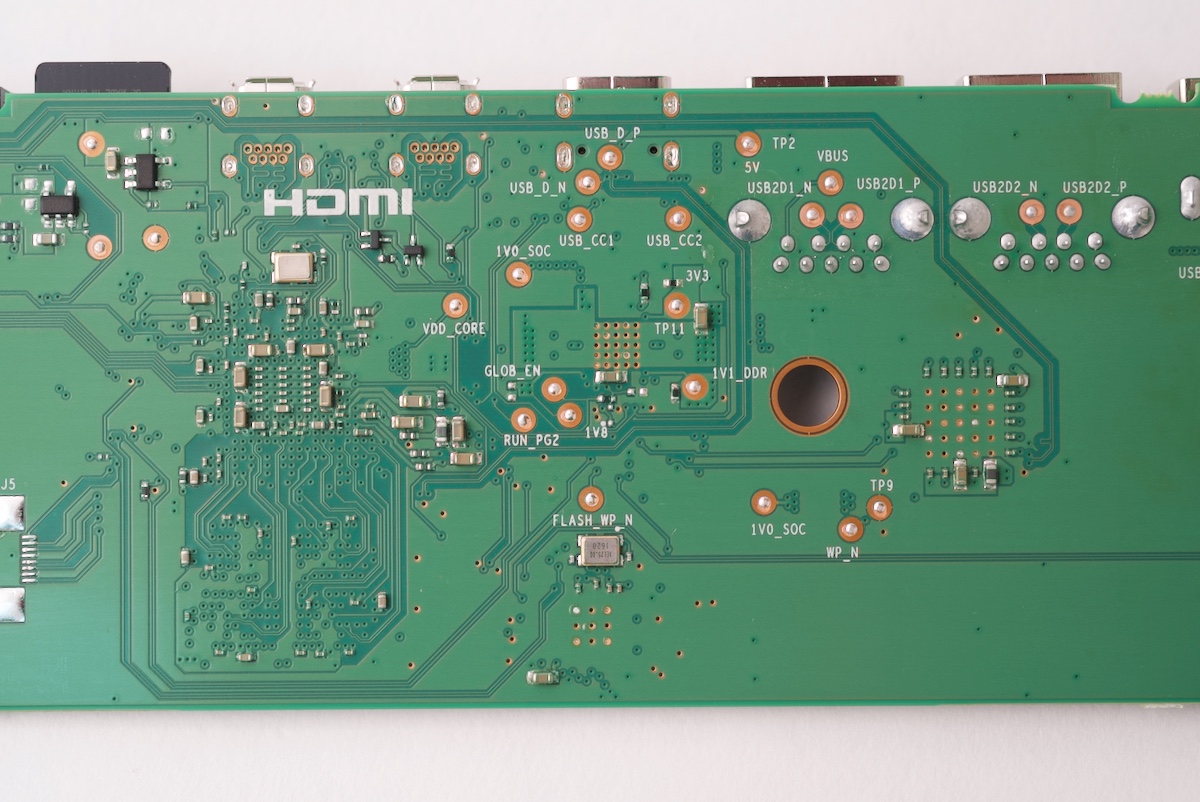
Finally, one shot with all the components that make up the Pi 400, including the little SanDisk Edge microSD card that's included with the computer:

Pi 400 Build Quality
As with all things Raspberry Pi, you're not going to get Apple-level hardware (no chamfered aluminium edges, diamond-blasted surfaces, stainless steel bands, etc.), but at least for the model I received, the plastic molds seemed to produce high-quality parts, and everything fit together (and survived four separate complete teardown-rebuild cycles!) very well.
I don't think this is a computer that most people will ever open up, but if you have the patience (and the right tool) to do so, it's not going to harm anything. Just be careful especially around the GPIO connector, as the case plastic is fairly thin in that area.
Pi 400 Performance
One thing you might notice in the Pi 400's specs is a new, higher default clock speed than you get with the year-old Pi 4 model B.
It's clocked at 1.8 GHz out of the box, while the Pi 4 model B is clocked at 1.5 GHz.
In some quick Phoronix benchmarks, the Pi 400 performed about 18% faster than the Pi 4 model B at the higher clock speed... which is expected, since that's the same ratio as the increase in megahertz.
But how is this higher clock possible? Well, not only is the massive heatsink helpful here—the Pi 400 didn't overheat even when I was running it with an overclock to 2.147 GHz, the maximum it allows currently—but the actual BCM2711 chip is different in this model:

The key difference here is the final "B0T" vs "C0T". That "C0" indicates the chip in the Pi 400 has a higher 'stepping' than the "B0" Pi 4. That means the chip has some minor bugfixes and improvements—in this case better thermal performance at higher clock speeds—and it can do more than the slightly older version of the same chip.
Fun fact: I just checked my Compute Module 4, and it, too, has the newer "C0" revision. Interestingly, it is still clocked at the same 1.5 GHz default as the Pi 4 model B.
In the end, it's not a massive difference, but it is a noticeable speed bump for many operations, and can even help make IO faster, for example if copying large files over the network to a fast USB 3.0 drive.
SanDisk Edge microSD Card
The Pi 400 includes a SanDisk Edge 16GB microSD card:

The card isn't a slouch, and is certainly better than most of the no-name or cheaper cards out there, but in comparison to two of the microSD cards I use and recommend the most (the Samsung Evo+ and SanDisk Extreme Pro A1), it leaves a bit of performance on the table:

The easiest performance upgrade for the Pi 400 is to replace the included microSD card with a faster (and larger!) card, and keep the SanDisk Edge card as a backup.
Or—and this feature is supported out of the box—boot from a USB SSD!
Other Notes
I'm still compiling some other thoughts about the Pi 400, as I have only just gotten it a week or so ago. I'll update this post over time with any new information.
- You can overclock the Pi 400 to 2.2 GHz, and even without any extra cooling, it didn't overheat after hours of use!
- The Raspberry Pi Blog posted an article about the design process: Designing Raspberry Pi 400
Conclusion
The Pi 400 is a great general purpose 'computer-in-a-keyboard'. I think it's a great option for someone who just needs to browse the web, edit documents, work on email, browse social media, and maybe even do some light photo or video organization.
It's not a substitute for something like a modern laptop or desktop if you need the horsepower and certain apps, but it offers a ton, and the software for the Pi is getting better every day, as more of the computing world increases Linux and ARM compatibility.
For my own needs, I often like to mount my Pi computers in custom cases or in places where I operate them headless. So I wouldn't necessarily buy a Pi 400 for that. But I do like it enough to stash it in my 'go' bag for networking tasks, and to have a computer at the ready anywhere I go. All I need is power, a TV, and a mouse—and technically I could skip that last bit!
You can buy a Raspberry Pi 400 Kit for $100 on the Raspberry Pi website.
Thanks to the Raspberry Pi Foundation for sending me a pre-release Pi 400 Kit, which was used in the production of this blog post and the associated videos.
Comments
Hahah! Just two weeks ago I found a use for the Scroll Lock Button after ~20 years of wondering what it's used for :)
The use case was in MS Excel that I am now obliged to use where this is a way to change the behavior of the arrow keys (scrolling cell by cell instead of moving the cursor).
I was looking for smooth half cell scrolling which apparently is asked too much in 2020 -.- ...
Yes, i'm using scroll lock.
So when you using Excel in the middle of sheet and you can see nearby cells. But often you need to see cells that are little bit beyond what you can see and make change on current cell.
People that doesn't use scroll lock navigate by mouse or keyboard to that cells and then navigate back to previous one.
People that use scroll lock - enable scroll lock, navigate using keyboard to that cells and then continue working - because current cell was remain same.
Try it! It's very useful!
Well... that's a good explanation—I never considered its utility in a spreadsheet!
Scroll Lock can be used also in text editors.
But specially on spreadsheet it's game changer!
Actually, the spreadsheet was the game-changer! The killer-app for the personal computer.
Lotus 1-2-3 - we made copious use of scroll lock, and not just because of the tiny monitors of the day (Duran Duran were number 1)!
I also agree with the previous mentions - I mainly (and I believe only) use scroll lock on spreadsheets.
I'm so old I used to use VT220 terminals where scroll lock was useful as it stopped stuff scolling :-D
CTRL+S does the same think on my terminals. CTRL+Q resumes it.
Great news. After seeing it, I was surprized nobody tried to come up with such a design earlier, and it didn't occur to me either.
Only compaint is that they didn't add pgup/pgdown/home/end as separate buttons. Having to use Fn prohibits, for instance, to select text in pages (shift+pgup/pgdn) or to begin/end of line (shift+home/end). That's why I stuck to Toshiba & MSI laptops (fortunately, their hardware and ports number are excellent too).
It's a design that's quite obvious in hindsight.
There were tons of computer-in-keyboard designs... in the 1980's.
That's interesting - I have a Pi using a 104 key mechanical keyboard as well as Mac that uses the Fn key and I have no problems selecting page up/down as well as begin/end of line. I have spent time on both digging into the key mapping though, so it just depends if those key combos are mapped properly (eg: shift+fn+up).
But there's no issue with holding down fn+shift+pg up/down or fn+ctrl+shift+end on laptops with pg up/down or home/end integrated with arrow keys via fn. In fact, when I get used to it, I became more productive than with detached buttons.
Scroll Lock is key to modern computing. :-)
This is a way to communicate with other device acting as USB-HID and reading the report. I did this with Circuit Python: https://twitter.com/DavidGlaude/status/1304556043465351169?s=19 and https://twitter.com/DavidGlaude/status/1305264345232879616?s=19
Also some use that LED to communicate with the user, but that should be possible with the activity key too. It could act as a network link up information.
I would love someone to make a tiny microSD distribution that turn this into a keyboard over the USB-C that can do Gadget mode, you just need a splitter to separate power from data.
I wonder if the USB-C connector already can do gadget mode. The Pi4 has this capability: https://www.hardill.me.uk/wordpress/2019/11/02/pi4-usb-c-gadget/
ScrollLock is in good use here as well for the KVM-switch. Pressing SCRL-L twice, followed by 1-4, to select any of four systems hooked up to the same keyboard/mouse/monitor.
What KVM are you using?
Does the Pi 400 have all the ports that RPi4 offered? I'm particularly curious about the display and camera connectors, as I don't see them in the pics.
> Aside: Has anyone reading this ever used scroll lock? I've at least used num lock before, but never scroll lock.
Yes, quite a lot frankly.
The Scroll Lock key is used on FreeBSD to lock/scroll the buffer in console, probably hence the name Scroll Lock :)
Thanks for nice review and teardown.
Regards.
I love this! Shame I still use Spotify and Discord, if not I would totally switch to the pi. I got zoom running on my pi and I have it set up on a standing desk for school meetings and its pretty neat.
Have you tried play.spotify.com? Is away for forgetting the client...
Discord can be used from a browser, so Nothing is stopping you from keeping a discord tab pinned for when you need it.
FreeBSD console uses scroll lock to turn on a mode where page up and page down scroll the display up and down a page at a time.
It would really have made more sense to use SysRq since I think only some particular versions of OS/2 ever used it instead of CTRL-ALT-DEL.
This is so cool. RPis are often used for real time sound work (audio installations, effects boxes, modular synth...) with a little bit of extra hardware for IO, so the educational uses extend that way too. Also really great to think of this in a server client setup with a little portable (touch) display.
Does the big heat sink interfere with the WiFi antennae connection?
In my (moderate sized) ranch house, no. I tried it in a few different areas and got 30-80 Mbps, depending on the distance to the router.
It's about the same as what I get out of the Pi 4, though I didn't do any scientific testing there.
Something else I just noticed, it doesn't seem to have an LCD panel connector.
Yeah the display and camera connectors are absent on the Pi 400. Forgot to mention that!
Can Chromecast be used to wirelessly stream video to a TV from the Pi 400 in a Chromium window? If not, are there other solutions to wirelessly stream video from the Pi 400 to a TV?
With official support for USB boot and benchmarks showing that an M.2 SSD drive over USB3 blows the doors off of MicroSD, it's disappointing that the 400 doesn't have a way to accommodate upgrading to internal M.2 SSD. Yeah, one could design a nice little external USB3 to M2 enclosure but that kinda defeats the point of the all in one design.
Also disappointing is 4GB instead of 8GB, and the lack of the ArmV8 cryptographic extensions on the SOC chip. The RockChip 3399 SOC used on the RockPro 64 supports the crypto extensions. In this day and age it seems silly to omit those instructions to get better crypto performance when so much relies on crypto.
It would be nice to have internal eMMC or M.2 suppport. I cross my fingers and hope a future "Pi 500" might have that :)
Yeah, or a Pi 430 with 32GB of eMMC and 8gb RAM
Right? The options are quite limited. I hope they would allow me to plug in my Titan GPU.
Have you tested it with ubuntu 20.10 by chance?
Not yet, though I know both Ubuntu themselves and Tom's Hardware have done some more extensive testing.
Running native ubuntu 20.10 on my Pi 400. Working nicely.
For me it is a big oversight that there are no ANY internal expansion capabilities - internal USB3 header or USB port, or maybe even one M2 slot. From electrical purposes I understand that it would require beefier power supply etc etc. But still it would be cool to have an eco system of internal expansion cards.
This is kind of like the Commodore 64 of Raspberry Pies. I'm sure it will sell well, and it should, but it doesn't solve any of the issues with the RP4 (see https://www.raspberrypi.org/forums/viewtopic.php?f=63&t=282840) that prevent the RP4 from being a serious desktop PC.
If you use Synergy KVM to control multiple PCs and screens with one keyboard and mouse from one PC, hitting Scroll Lock will lock you in the screen you are controlling. Nifty if you are... say... playing TF2 and controlling it with your Pi.
Is it possible to power it with Power-over-Ethernet? I noticed there is a SM51625EL Ethernet Transformer on the board behind the ethernet jack but don't see mention of it being PoE capable.
Nope! The chip supports it, but the Pi 400 doesn't have the power circuit inside to be able to tap into the PoE power. At least not in this initial revision of the Pi 400. I'm guessing it was not included for cost reasons, as there is space on the board that could be used for it.
Thank you for the great content! Wish I had been able to watch your linked videos sooner, looks like you covered it in the tear-down video as well. :)
I see two curiosities: the unpopulated J5 connector on the rear, and the pads next to the ethernet port also look like another unpopulated connector. What are they for?
Maybe the ethernet was designed with the option of PoE?
My guesses are:
J5 = jtag
pads by ethernet = for ethernet activity LEDs
What is that “keyboard matrix”?
its for the keyboard - it's SOOOO exciting that they've exposed the underside pads like this....prepare for 3rd party matrix quick add ons!
Great review!! Could you also test the temperature under heavy load condition for longer time? Thanks!
I am testing that right now, and a video will be coming shortly :)
Great write up, thank you. I'm keen to see how it lasts heat-wise, over the. My 4b is awful sensitive to heatsink design/fit.
Looking forward to hearing more about this gadget!
Brilliant development on the PI. Priced well, minimalist design and good asthetics. As a project board that is ever closer to a full use PC, this makes sense to deliver a simple out of the box experience. Great for kids that don't yet have a PI to experiment and learn on. I have used this form factor in the past and it works well. Thanks for an informative review, Jeff.
Could you solder or otherwise attach a mechanical keyboard pcb to this Pi board?
It's probably possible, though I'd suggest trying to pull the Pi 400 board out and integrate it into a larger mechanical keyboard case instead of hacking a mechanical keyboard on top of the Pi 400 lower case.
Can the SD card be replaced with a SSD drive ?
You didn't describe the one feature that the 400 has and almost all laptops and desktops don't have : the breakout GPIO pins. How do you use these in the 400? Other cards connect to USB ports on an external computer and (I assume) you program the board using the UI on your computer. How do you do this w/o a USB port dedicated to connecting to an external computer? Is there a UI built into the Unix system? What?
Has anybody accidentally spilled coffee or something into your keyboard? Did it work anymore? How many years before something fails on a keyboard -- for me, it's about 3 years. Do keyboards get banged around a lot? Yes. Are they a super-personal thing -- how they feel, the size, other aesthetics? (I use wired ThinkPad keyboards because I like the feel of the keys and their locations). So I hate to pour cold water on this product, being a big RPi supporter (have *every* board since the beginning), but --- unless schools are the target market, these things are less versatile, more expensive, and probably less robust than the existing RPi4. You are missing the camera connector, the display connector, a USB2 port, LEDs on the Ethernet jack, and any chance you can 'move something' to improve WiFi / BT range. The RPi 400 is a terrible idea. Better: stick an RPi4 on the back of a cheap 4K monitor, use a wireless keyboard with built-in trackpad or Stick. You have the freedom to put the keyboard in your lap, and the stuff that 'doesn't move after setup (Ethernet cable, power supply, HDMI cable) is not constantly moving and/or being jostled by normal everyday keyboard use.
Having additional choices is not a bad thing. You are still free to do exactly what you propose, and those who like this product can take advantage of it. Keyboards can be cleaned if spilled on, and, in the worst case, you can probably buy the $20 Raspberry Pi keyboard and swap it out with the Pi 400 keyboard. If you don't like the Pi 400 keyboard, you are free to use your own with the Pi 4, as you were before. Nothing has been taken away from you, and something has been provided by those who want it.
Bro I spilled a mud jug full of dip spit on a mechanical keyboard back in the day. Unplugged it, took it outside and hit it with the garden hose and left it to dry for two weeks and it still works great. I'm pretty careless and drunk and to be honest I've not broken a keyboard in many many years. The RPi 400 probably wouldn't survive that but you keep talking about keyboards like they just wind up breaking all the time.
I wonder if a battery could be squeezed in there?
Looks like there may be some room if you trim away the heatsink in the quarter where the keyboard ribbon plugs in, but perhaps the better bet is on the outside of the case under the flat keyboard area (where it rises above the desk).
Is there a way to run win10 on this platform? My application is to run the Xilinx IMPACT tool for programming FPGA in a test environment, where it will be dynamically updating the bitstream to the target FPGA based on GPIO inputs. My other choice is a small all in one box, or PC-104 hardware.
Is new Pi 400 better than Pi 4 model B. On comparing specs, Pi 400 have 1.8 GHz compare to 1.5 GHz bit only limited 4Gb RAM where as we can 8GB in earlier model.
I would say it's about the same as a model B, all things considered. Obviously you can get an 8 GB version of the Pi 4, but the CPU in it is currently a slightly older revision. That doesn't mean too much performance-wise (you can safely overclock most Pi 4 model B computers to 1.8 GHz and beyond), but it can mean better heat/thermal performance on the Pi 400 (especially with it's giant heat sink).
Thanks for your quick response !!
I saw news about the 400 on slashdot, and 10 minutes later had ordered one. I've never owned a Pi before. I'm curious about the lack of a headphone jack. I know I can use USB/bluetooth headphones, but a friend more familiar with Pi's said other models have had them. It it just a ROI for the space the headphone jack would take up?
Yeah, the engineers mentioned that they had to ditch the 3.5mm jack because there just wasn't space if they wanted to include all the other plugs on the back. They recommended USB audio, HDMI passthrough, or using Bluetooth.
One thing I do wish the Pi engineers would have done: since there's lots of unused circuit board area, they could have put the traces down for features that were not included (audio jack, camera, lcd, etc.). Left unpopulated, this should cost nothing except the time to lay them out. Folks with enough know-how could go ahead and populate the missing components. However, without access to the "pins" (balls on the main chip), such add-ons are virtually impossible.
Quick Q - did anyone try yet to check issues of USB-C power supplies compared to earlier PI4 version issues on same? The later revision of PI4 board resolved it - i assume PI400 addresses better this issue.
That issue is still fixed on the Pi 400. It uses the same power circuit (as far as I can tell) as the newer revision Pi 4.
How about Gpu clocking?
Is it possible to clock gpu higher than 750Mhz? I think it was regular pi4 max gpu clock.
It sucks they removed Scroll Lock thus breaking console scrolling in FreeBSD.
Hi Jeff - a bit of a random question - I have need of a USB keyboard once in a blue moon for troubleshooting - does the RP400 still work as a USB keyboard with PCs like the Raspberry Pi keyboard did? Cheers!
There's a way you could make it work by customizing a Pi OS image to use the USB OTG port via USB-C so it would behave as a keyboard when attached to a computer, but it would be a pretty inefficient and expensive way to do that!
Is it too early to ask at this time if you can load iRaspbian or any other Apple-like OS to the 400?
Thank you for such a great review. My 12 yr old son wants to get into programming and hosting a server. Can this do that? It seems nice to already have a keyboard so I was thinking this might be better than the standalone Raspberry Pi 4.
Is that 4GB Ram will couse some performance drops comparing to 8GB version in some cases?
Thanks for a great review. Did you happen to notice whether the wifi speed compares to other devices? on my 400 I'm noticing that wifi speed is approx 50% slower than comparable on a PC. More broadly, do you know of any ways to tweak the system to increase the wifi speed. Its decent as is, don't get me wrong - more a point of issue.
Compared to my MacBook Pro which gets ~900 Mbps over my home 802.11ac network, it's a lot slower.
But it's about the same as other Pi 4s I have used, getting around 40-80 Mbps on the same 5 GHz network. I wouldn't expect the Pi's WiFi to get nearly the same performance as a laptop or desktop with a special antenna configuration and usually a better wireless chipset. I usually use the wired networking if I need more performance.
Was the circuitry for the headphone (and more importantly the composite video) removed, or just the jack? Can I solder on connectors to get composite video back?
I see your review and i believe it is interesting. Being a rookie on Raspberry, i want to ask you if this can be used for video conference. I would like to buy for my son and allow him to use to connect with school in these days of Covid in italy. So can be add a camera via usb ? what software need to be added for video conferences ( Zoom. skype, etc). thanks for response.
Yes, it can be used for video conferencing, with most any USB video camera (I tested a Logitech, but there are many that people have tested and are working).
Note that some of the video chat software might not work on the Pi out of the box. I haven't tested Skype, but I know Zoom and Google Meet have worked, at least.
Would it be possible to place a nvme ssd in a USB-C enclosure inside the PI, drill a hole in the case and connect it to the external cable? Something like this: https://www.axagon.eu/en/produkty/eem2-ug2 - (AXAGON EEM2-UG2) with dimensions 115 x 39 x 11 mm - would it work thermally as well? It is quite a hack, but for a pi that would mostly stay in one place, I think it could work.
Self-reply after buing the unit - probably not, I ahve not tried to open it but there is probably no real empty space inside the case.
I'm hoping someone designs an STL file that I can print that'll replace the bottom plastic case with a version that has a bit more vertical space that can hold a small ssd drive adapter with it's USB-C adapter pointing rearward so I can just loop the cable to the USB3 port. I'm frankly surprised that no one has done that yet. An internal ssd would make the Pi400 much more useful to me.
Hey Jeff, Great review! This post and the Overclocking one made me get a Pi 400 myself. Thanks!
If you find Chrome's performance is a bit lacking, freezing up while scrolling while booting off the microSD, to get a bit more IO performance, you can move the .cache directory to a RAM disk, using tmpfs by adding the below line to /etc/fstab:
tmpfs /home/pi/.cache tmpfs noatime,nodev,nosuid,size=400M 0 0
Source:
https://wiki.archlinux.org/index.php/Chromium#Cache_in_tmpfs
https://www.raspberrypi.org/forums/viewtopic.php?t=257747
Hi Jeff.
Does the keyboard present as USB or PS/2?
Does anyone know if we can get a Keyboard Keys Hinge Clip as the when i received my Pi 400 Kit the Ctrk Key in the lower left hand of the keyboard was unattached and loose in the box, the keyboard itself seems to have taken a hard knock in shipment causing the keyboard Key Hinge Clip to have broken.
Thanks Jeff for the teardown, it showed areas of free space that could be used to add stuff inside Pi400.
"To get it open, I used a plexiglass cutter, which is the only tool I have that's thin enough to get into the side clips that hold the white keyboard top to the red plastic shell underneath, but also rigid enough to un-pop the snaps."
I only had a nornal screw driver, and even with that I was remove the keyboard form Pi400 bottom. I did that 4 times already sofar.
Today I completed implanting small RTC (Real Time Clock) module into Pi400 inside -- nice!
https://www.raspberrypi.org/forums/viewtopic.php?f=140&t=293675&p=17752…
Nice! I wish there was a little more room inside the case for modifications, or heck, there's even room enough on the board for something like an RTC/coin battery, so maybe in the next revision...
Yes i used it a lot about 30 years back and a few times since. It was nice to have when the shell was dumped full of text that just scrolled away with no buffer, but computers have been to fast for a long time for it to have any meaning at all. It is just a spec in the standard for keyboard needed to call it a standard key layout. :-)
If you were to open a few of these up and replaced the microSD cards could you cluster them together? 4gb Raspis are up in price.